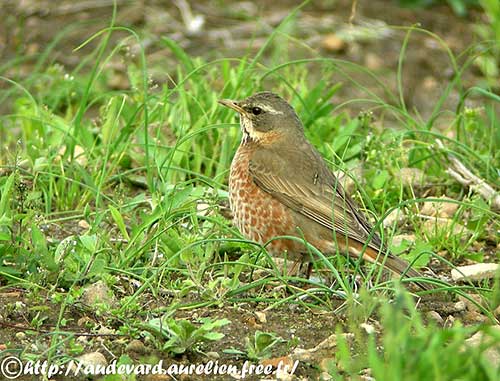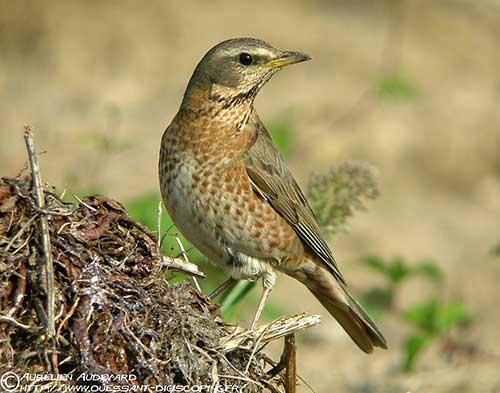
CALLS AND SONGS: SOUNDS BY XENO-CANTO
The call of the Naumann’s Thrush includes a loud, shrill “cheeh-cheeh” often repeated several times, and harsh repetitions of “ket”, “cha” and “kra” notes. It also utters a chuckling “chak-chak” recalling the Fieldfare. The flight calls include some “srrii-i” recalling the Redwing.
The song is melodious and quite fluty, ending in trill or twitter, a rather flat, slow “tyee-tryu-uu-tee twee-tryuuuu-tuee” ending in rising “tsee-tsee-tee”.
The song is often given from perch in tree, usually in the morning and the evening, and sometimes at night. In wet weather conditions, the bird may sing throughout the day.
BEHAVIOUR IN THE WILD:
The Naumann’s Thrush feeds primarily on insects and their larvae, mainly mosquitoes and numerous worms during the breeding season. In autumn, it consumes seeds and berries (Phellodendron amurense), rowan (Rosaceae), bilberries, grapes and buckthorn (Rhamnaceae).
It forages by walking and hopping on the ground over short distances before stopping.
During winter, it often forms flocks around food sources and at roosts. If disturbed, it flies off some distance and is slow to come back.
During the breeding season, the male is territorial and sings from perches in trees to proclaim the territory, while the female builds the cup-shaped nest in tree or bush. This species is probably monogamous, like most Turdidae species.
The Naumann’s Thrush is migratory and leaves the breeding areas in Russia from September to November, migrating southwards to China, through Mongolia and Korea.
The return in spring extends from April to early June. The migration continues through April in SE Russia, with arrival in May on the breeding grounds.
Some vagrants are recorded as far west as W Europe.
In flight, the Naumann’s Thrush looks fairly dumpy, recalling the Fieldfare.
REPRODUCTION OF THIS SPECIES:
The breeding season occurs from mid/late May to early August.
The Naumann’s Thrush builds a cup-shaped structure low in tree or bush, between 3 and 5 metres above the ground. The nest is made with grass, moss and thin twigs, and the cup is lined with softer grasses and mud.
The female lays 3-5 eggs similar to the eggs of the Common/Eurasian Blackbird. The incubation lasts 13-15 days, mainly by the female. No more information.
PROTECTION / THREATS / STATUS:
The Naumann’s Thrush is described as fairly common to common according to the range.
Modification of the habitat probably impacts the population size. It is also hunted for food in China.
However, the species is not globally threatened, and the Naumann’s Thrush is currently evaluated as Least Concern.
Fr: Grive de Naumann
Ang: Naumann’s Thrush
All: Rotschwanzdrossel
Esp: Zorzal de Naumann
Ita: Cesena di Naumann
Nd: Naumanns Lijster
Sd: rödtrast
Photographer:
Aurélien Audevard
OUESSANT DIGISCOPING
Text by Nicole Bouglouan
Sources:
HANDBOOK OF THE BIRDS OF THE WORLD Vol 10 by Josep del Hoyo-Andrew Elliott-David Christie - Lynx Edicions - ISBN: 8487334725
THRUSHES by Peter Clement and Ren Hathway – HELM - ISBN: 0713639407
A Field Guide to the Birds of South-East Asia by Craig Robson. New Holland Publishers. ISBN: 9781780090498
BIRDS OF THE MIDDLE EAST by R.F. Porter, S. Christensen, P Schiermacker-Ansen C.Helm - ISBN: 0713670169
Wikipedia, the free encyclopaedia
Naumann’s Thrush
Turdus naumanni
Passeriformes Order – Turdidae Family
INTRODUCTION:
The Naumann’s Thrush was formerly treated as conspecific with the Dusky Thrush (T. eunomus), but both are now full species.
The Naumann’s Thrush breeds in C and E Siberia, S to N Mongolia. It spends the winter in Ussuriland, N Korea and S China, S to Taiwan.
It breeds in forested areas and nests in trees or bushes. During winter, it can be seen in open forests, cultivated areas and suburban parks. This species feeds mainly on insects and various invertebrates, and also consumes seeds and berries in autumn.
The Naumann’s Thrush is described as fairly common to common, and it is not globally threatened.
The name of this species pays tribute to the German naturalist Johann Andreas Naumann (1744-1826).

DESCRIPTION OF THE BIRD:
Biometrics:
Length: 23-25 cm
Weight: 63-80 g
The Naumann’s Thrush adult male is much greyer than the Dusky Thrush, with almost unmarked grey-brown upperparts. The area from rump to tail is strongly rufescent. On the grey-brown upperwing, scapulars to median coverts show reddish-rufous edges.
The underparts are cinnamon-red with white scaling on breast and flanks. Centre and lower belly and vent are white with scattered dark scales.
On the head, crown, ear-coverts, cheeks and lores are grey-brown, whereas long supercilium and face are rufous to buffish. There is an indistinct blackish malar stripe. Chin and throat are cinnamon-red.
The bill is blackish with yellowish lower mandible. The eyes are dark brown. Legs and feet are yellowish-brown.
The female is paler and duller than male. On the upperparts, the reddish-rufous edging is absent and the tail is paler, less strongly rufescent.
Head sides are duller rufous and more pinkish to buffish. The upper throat is whitish but the dark malar markings are stronger.
The juvenile is heavily streaked with buff and dark brown on mantle and scapulars, and it has mostly black spotting below.
The first winter resembles adult male on the upperparts, but the underparts are more similar to female. The rufous colour is variable.
RANGE:
The Naumann’s Thrush breeds in C and S Siberia, but the southern boundary is not well known. Small populations breed N of main range near Lena and Olenek deltas.
It winters from extreme SE Russia, N Korea and E China, S to Yangtze basin and Taiwan. It is scarce in Japan and rare in Tibet.
HABITAT:
The Naumann’s Thrush breeds in open forests and larch and dwarf willow thickets in the shrub-tundra area, and at edges of woodlands with various tree species. During winter and on passage, it frequents similar habitats but more open areas such as lowland flood plains, scrub oak (Quercus), edges of cultivated fields and pastures, stubble fields and suburban parks.
